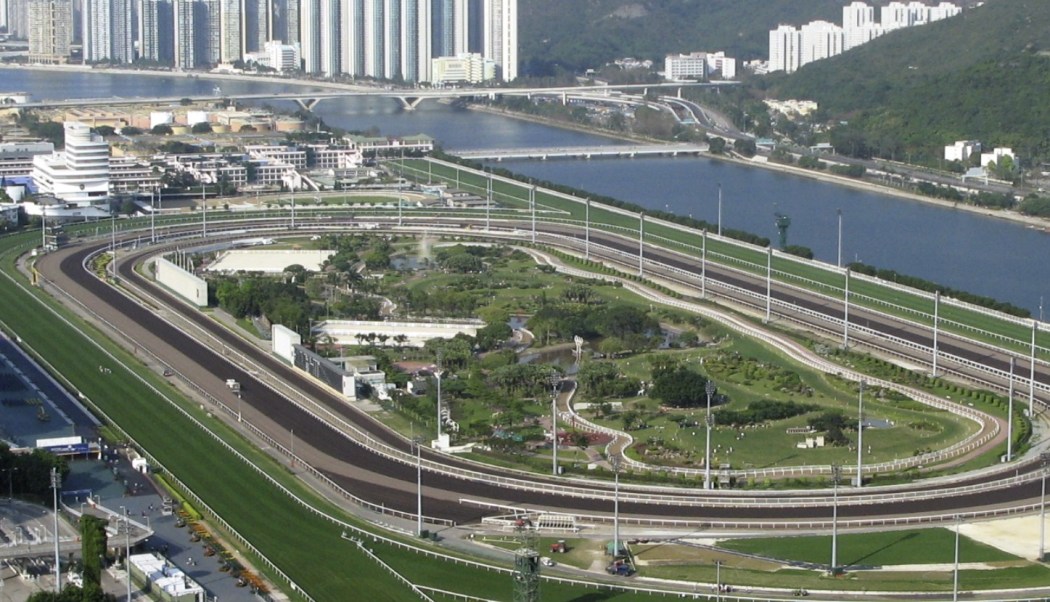Since the dog and I had a snake encounter last summer Lemon refuses to visit our local Country Park. The rather boring local alternative is walking up and down Sui Wo Road. So after years of passing it unnoticed I now resort regularly to Penfold Park.

Penfold Park is a unique Hong Kong institution. It is not run by the government or local authority. It occupies the space inside the race-track at the Jockey Club’s Shatin horse casino.
Cynics may wonder if the Jockey Club’s haste to install a public park was in any way motivated by the desire to put something in the space before the government noticed that it was not actually needed for horse-racing purposes, and put something less decorative in there.
A close look at the architecture suggests that in the early days someone cherished the idea that some of the less strenuous horse activities would take place there. There is a trotting track, some practice jumps and a clear space on which one might gallop. But I have never seen so much as a hoofprint so I suppose this idea has faded away.

More successful was the idea that this might be a family attraction. There are toilets, a playground for the kids, and plenty of tables and benches for picnics. And on public holidays or weekends with good weather you do see some parties enjoying alfresco meals.
But the main beneficiaries of Penfold Park are dogs. The park is a dogs’ delight, a pooch paradise, Hong Kong’s hound heaven. Most days a visitor without a dog will feel undressed. On holidays there are dog crowd scenes. The park is decorative, with pools, paths, sculpted bushes and artistically clustered trees. But most importantly for dogs it has a very large area of grass.
Municipal parks in the territory have traditionally been adorned with forests of signs discouraging things: smoking, music, ball games, cycling, roller-skating, radio-controlled cars and, of course, dogs.
Regular readers will have gathered that I am not a great fan of the Jockey Club – an addictive vice does not become a virtue when decorated with conspicuous consumption, snobbery and animal abuse – but I have to admit that with the park the club has done a stellar job. It continues to do so – the park is meticulously maintained, bushes pruned, grass cut, fences painted – and offers no prohibitive notices except a small one pointing out that drones are banned on race days, when the park is closed anyway.

This leads us to one fly in the ointment: there is no public transport. The racecourse has a station, but it is only open on race days. There is a large car park and some people come in taxis. This is not a park for poor people.
Bearing this in mind the observant anthropologist can still spot some interesting characteristics of the local dog population, albeit at the more soignee end of the spectrum.
Interesting mixtures like my Lemon are numerous but not in a majority. The pedigree population comes in two categories. There are the display dogs: Old English sheepdogs, Collies, the odd Afghan hound, some spectacular retired (I presume) Greyhounds. Some of these seem rather impractical for Hong Kong’s climate. Two popular choices in this category are Huskies (anyone for three hours’ exercise a day?) and Samoyeds.
Then there is the most numerous group: very small dogs and extremely small dogs. These are mostly miniature Poodles but Yorkies and other midget breeds are also popular.

The size of this group reflects, I fear, the restrictions which many landlords – notably the government – impose on dog ownership in the properties they rent out or sell. A very small dog can be smuggled in and out in a bag. Designed bags for this purpose are a common offering in pet equipment shops. With your pocket pooch in a bag you can also, in flagrant violation of the regulations, take it on the MTR.
Owners in this category go for pedigrees for two reasons. The dog adoption people will refuse to offer you a dog if you live in an estate where they are banned, because too many dogs adopted in these circumstances are returned. So if you want a dog you must buy one.
From the owner’s point of view a pedigree dog is a better bet because you have a good idea of how big the tiny puppy you are looking at is going to be as an adult, a point on which the adoption people may not be very helpful. Most adoption dogs are mixtures so you cannot exclude the possibility of a Great Dane granddad in the family tree somewhere.
This suggests that the blanket ban on dogs in government-controlled estates has a curious and perhaps not very useful effect. It keeps commercial dog breeders in business and hampers the efforts of those organisations trying to encourage the adoption of existing dogs rather than the breeding of new ones.

A more general public policy worry is the number of young couples whose relationship with their dogs suggests that the pooch may be a surrogate for something else. Small dogs are wheeled out in dog strollers, primped in dog beauty parlours and dressed in cute gear. A newly opened café in Shatin catering for owners and their (small) dogs seems to be doing good business.
Is there a consensus among the (disillusioned?) young that raising a dog is preferable to having real kids? After all a dog is cheaper, easier to manage, and will never get big enough to want a room of its own. And you don’t have to worry about the merits of kindergarten classes in goosestepping and flag worship.
Support HKFP | Policies & Ethics | Error/typo? | Contact Us | Newsletter | Transparency & Annual Report | Apps
Help safeguard press freedom & keep HKFP free for all readers by supporting our team
| HKFP is an impartial platform & does not necessarily share the views of opinion writers or advertisers. HKFP presents a diversity of views & regularly invites figures across the political spectrum to write for us. Press freedom is guaranteed under the Basic Law, security law, Bill of Rights and Chinese constitution. Opinion pieces aim to point out errors or defects in the government, law or policies, or aim to suggest ideas or alterations via legal means without an intention of hatred, discontent or hostility against the authorities or other communities. |

More HKFP OPINION:
HKFP has an impartial stance, transparent funding, and balanced coverage guided by an Ethics Code and Corrections Policy.
Support press freedom & help us surpass 1,000 monthly Patrons: 100% independent, governed by an ethics code & not-for-profit.










